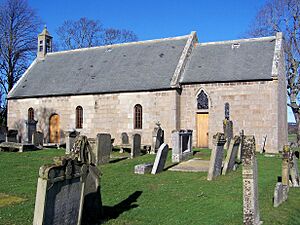Birnie Kirk facts for kids
Birnie Kirk is a very old church near Elgin, in Moray, Scotland. It was built in the 1100s, which makes it a 12th-century church. For a long time, it was the main church, or cathedral, for the Bishop of Moray. It is one of the oldest churches in Scotland that has been used continuously for worship.
In November 2023, news reports said that Birnie Kirk would close by 2027. This is part of big changes happening in the Church of Scotland. Even though it closed for regular services, the church building is still being looked after. Since January 2024, a different church group, the Roman Catholic Church's Personal Ordinariate of Our Lady of Walsingham, has been using it for weekly evening prayers and monthly Mass.
Contents
Discovering Birnie Kirk
Birnie Parish Kirk is a special church from the 1100s. It is a Norman-style church located about 4 kilometers (2.5 miles) south of Elgin, in Moray, Scotland. Birnie is one of the oldest churches in Moray that has been used without stopping. People think this Norman building replaced an even older Celtic church from the 500s.
What the Church Looks Like
The church is built from finely cut stone called ashlar. It has a rectangular shape with a short, square area at the front called a chancel. A round arch, typical of Norman style, separates the chancel from the main part of the church, called the nave. The nave was made shorter in 1734, and the church was fixed up again in 1891.
Inside the chancel, there is a Celtic bell. People believe it was made in Rome and blessed by the Pope a long time ago. You can also see a Bible from the 1600s. It is covered in calf's fur and is known locally as the "Hairy Bible." In a corner of the nave, there is a simple font, which is a basin used for baptisms. The church also has tall, narrow windows called lancet windows on its north and south sides.
Birnie Kirk's Role as a Cathedral
Birnie Kirk was very important in the past. It was the main church for the Bishops of Moray from 1107 to 1184. It served as a cathedral until 1322. During that time, the main church for the bishop moved between Birnie, Kinneddar, and Spynie. Simon de Tonei, who was the fourth bishop, was buried here in 1184. However, his grave cannot be found today.
The Churchyard and Symbol Stone
The church is surrounded by an oval-shaped burial ground. This shape suggests that it was an early Christian site. A special stone called the Birnie Symbol Stone stands against the west wall of the churchyard. It is a Pictish symbol stone, which means it was carved by the ancient Picts. This stone is made of granite and is about 1.07 meters (3.5 feet) tall. It has Celtic designs carved into one side, including a sea-lion, a Z-rod, and a rectangular shape.
The cemetery also has a war memorial. This memorial honors local people who died during World War I and World War II. It looks like the end of a small chapel and has two plaques under a Romanesque arch.
A Look Back at Birnie Kirk's History
Before the current church was built, this spot was already important. It was the first home for the Bishops of Moray. The oval shape of the churchyard hints that there was an early Christian area here.
In 1969, the graveyard was named a scheduled monument by Historic Environment Scotland. This means it is a very important historical site. The church building itself was listed as a "Category A" building in 1971. This is the highest level of protection for historic buildings. In 1997, the scheduled monument was updated to include the symbol stone and any old remains under the church.
As mentioned, the church stopped holding regular services after a final special service on November 19, 2023. Since January 2024, it has been used by the Roman Catholic Church's Personal Ordinariate of Our Lady of Walsingham for weekly evening prayers and monthly Mass.
See also


